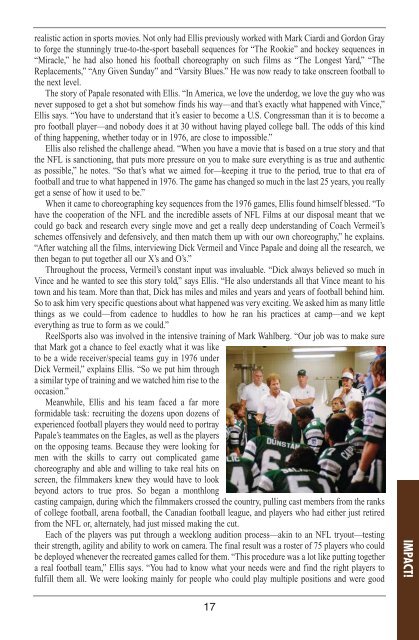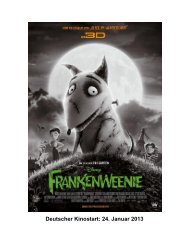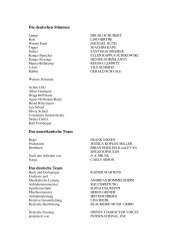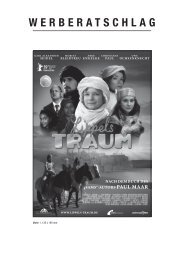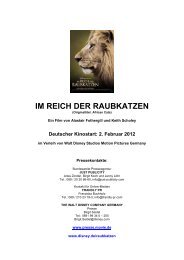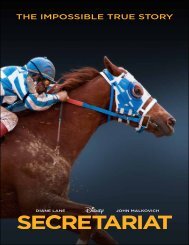invincible - Walt Disney Studios Motion Pictures Germany
invincible - Walt Disney Studios Motion Pictures Germany
invincible - Walt Disney Studios Motion Pictures Germany
Create successful ePaper yourself
Turn your PDF publications into a flip-book with our unique Google optimized e-Paper software.
ealistic action in sports movies. Not only had Ellis previously worked with Mark Ciardi and Gordon Gray<br />
to forge the stunningly true-to-the-sport baseball sequences for “The Rookie” and hockey sequences in<br />
“Miracle,” he had also honed his football choreography on such films as “The Longest Yard,” “The<br />
Replacements,” “Any Given Sunday” and “Varsity Blues.” He was now ready to take onscreen football to<br />
the next level.<br />
The story of Papale resonated with Ellis. “In America, we love the underdog, we love the guy who was<br />
never supposed to get a shot but somehow finds his way—and that’s exactly what happened with Vince,”<br />
Ellis says. “You have to understand that it’s easier to become a U.S. Congressman than it is to become a<br />
pro football player—and nobody does it at 30 without having played college ball. The odds of this kind<br />
of thing happening, whether today or in 1976, are close to impossible.”<br />
Ellis also relished the challenge ahead. “When you have a movie that is based on a true story and that<br />
the NFL is sanctioning, that puts more pressure on you to make sure everything is as true and authentic<br />
as possible,” he notes. “So that’s what we aimed for—keeping it true to the period, true to that era of<br />
football and true to what happened in 1976. The game has changed so much in the last 25 years, you really<br />
get a sense of how it used to be.”<br />
When it came to choreographing key sequences from the 1976 games, Ellis found himself blessed. “To<br />
have the cooperation of the NFL and the incredible assets of NFL Films at our disposal meant that we<br />
could go back and research every single move and get a really deep understanding of Coach Vermeil’s<br />
schemes offensively and defensively, and then match them up with our own choreography,” he explains.<br />
“After watching all the films, interviewing Dick Vermeil and Vince Papale and doing all the research, we<br />
then began to put together all our X’s and O’s.”<br />
Throughout the process, Vermeil’s constant input was invaluable. “Dick always believed so much in<br />
Vince and he wanted to see this story told,” says Ellis. “He also understands all that Vince meant to his<br />
town and his team. More than that, Dick has miles and miles and years and years of football behind him.<br />
So to ask him very specific questions about what happened was very exciting. We asked him as many little<br />
things as we could—from cadence to huddles to how he ran his practices at camp—and we kept<br />
everything as true to form as we could.”<br />
ReelSports also was involved in the intensive training of Mark Wahlberg. “Our job was to make sure<br />
that Mark got a chance to feel exactly what it was like<br />
to be a wide receiver/special teams guy in 1976 under<br />
Dick Vermeil,” explains Ellis. “So we put him through<br />
a similar type of training and we watched him rise to the<br />
occasion.”<br />
Meanwhile, Ellis and his team faced a far more<br />
formidable task: recruiting the dozens upon dozens of<br />
experienced football players they would need to portray<br />
Papale’s teammates on the Eagles, as well as the players<br />
on the opposing teams. Because they were looking for<br />
men with the skills to carry out complicated game<br />
choreography and able and willing to take real hits on<br />
screen, the filmmakers knew they would have to look<br />
beyond actors to true pros. So began a monthlong<br />
casting campaign, during which the filmmakers crossed the country, pulling cast members from the ranks<br />
of college football, arena football, the Canadian football league, and players who had either just retired<br />
from the NFL or, alternately, had just missed making the cut.<br />
Each of the players was put through a weeklong audition process—akin to an NFL tryout—testing<br />
their strength, agility and ability to work on camera. The final result was a roster of 75 players who could<br />
be deployed whenever the recreated games called for them. “This procedure was a lot like putting together<br />
a real football team,” Ellis says. “You had to know what your needs were and find the right players to<br />
fulfill them all. We were looking mainly for people who could play multiple positions and were good<br />
17<br />
IMPACT!


